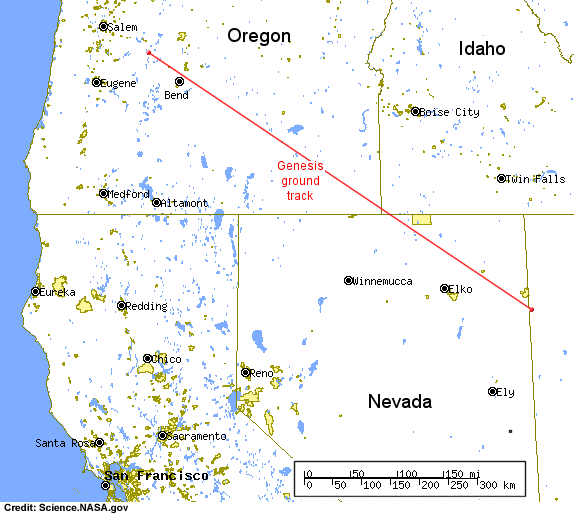Genesis Re-entry to Create Fireball in Western Sky

Meteors are unpredictable. You never know, not exactly, when one will streak across the sky.
Not so on Wednesday, Sept. 8. At precisely 8:52:46 a.m. Pacific Daylight Time (PDT), northwest of Bend, Oregon, a fireball will appear: a white-hot dot of light, brighter than the planet Venus, gliding across the blue morning sky.
This is no ordinary meteor. It's a space capsule jettisoned by NASA's Genesis spacecraft, returning to Earth with precious samples of the Sun, and we know exactly where it will go:
From Bend, traveling 25,000 mph (11 km/s), the fireball will streak across eastern Oregon, brightening as it descends into denser parts of Earth's atmosphere. At 8:53:35 a.m. PDT it crosses the southwestern corner of Idaho and, moments later, northern Nevada not far from the tiny town of Elko. Finally, at 8:54 a.m. PDT, slowed to a near-halt by the capsule's drogue parachute, the fireball will fade over Utah.
Sky watchers as far away as 100 miles from the reentry path could see the capsule glowing "10 to 100 times brighter than Venus," says meteor expert Peter Jenniskens of NASA's Ames Research Center. For comparison, that's about as bright as a fat crescent Moon. Jenniskens expects the fireball to be most luminous (visual magnitude -9) when it is over Nevada.
To people within viewing range, he offers this advice: "Unless you're directly beneath the reentry path, the fireball will be low in the sky, so pay attention to the horizon. Try using binoculars to increase the contrast between the bright blue sky and the fireball. But do not look toward the Sun." Focused sunlight can blind you--permanently.
Jenniskens will be watching the reentry himself from the air, along with 20 other scientists, inside an Air Force NKC-135 aircraft. The plane is equipped with a battery of telescopes and spectrometers pointing out of 20 upward-looking windows. In years past, the NKC-135 has flown to study Leonid meteor showers. This time "we plan to study the hot shock wave in front of the capsule," explains Jenniskens.
Get the Space.com Newsletter
Breaking space news, the latest updates on rocket launches, skywatching events and more!
Astrobiologists are interested because meter-sized asteroids--coincidentally, about the same size and velocity as the Genesis capsule--hit Earth several times a year, bringing organic materials from space to our planet. Do these molecules survive reentry? Could they react with atmospheric gases in the hot cauldron of their own shock wave to create new materials of biological importance?
"We don't know," he says. "It's so hard to catch a genuine asteroid in the act of re-entering." Genesis is a rare "meteor on cue."
Watching the reentry, exciting and fruitful as that may be, is merely a prelude to the main event:
Once the fireball is spent, a parafoil will pop out and the capsule will glide gently toward the US Air Force's Utah Test and Training Range, southwest of Salt Lake City. If all goes as planned, Hollywood stunt pilots -- no kidding! -- will pluck the capsule from mid-air using a long hook extended from a helicopter's belly. This prevents delicate sample holders from breaking on the ground below.
The samples are bits of the Sun -- the solar wind, actually -- which Genesis has spent the last 27 months collecting. Scientists believe the solar wind is almost identical in composition to the primeval solar nebula, the cloud from which the Sun and planets condensed 4.5 billion years ago. Examining pristine bits of the solar wind amount to examining the "stuff" of our origins--hence the name "Genesis."
"The excitement really begins when scientists around the world get hold of these samples for their research," says Genesis principal investigator Don Burnett of the California Institute of Technology.
A star-spangled entrance. A Hollywood ending. And that's just the beginning? Stay tuned.
- Genesis Mission: Complete Coverage
- A Detailed Map of the Re-entry Path
- 'Mystery Cloud' Appears Over Eastern U.S. And Canada
- Photo of Fiery Object Mystifies Scientists
- See Venus in the Morning Sky
- See Elusive Mercury Now, Too
Join our Space Forums to keep talking space on the latest missions, night sky and more! And if you have a news tip, correction or comment, let us know at: community@space.com.
Tony Phillips is a professional astronomer and science writer who received a PhD from Cornell University in 1992. He is best known for his authorship of Spaceweather.com. In his career, he has worked as a radio astronomer at Caltech and published more than 100 articles in research journals such as Nature, the Astrophysical Journal, and the Journal of Geophysical Research. Among his astronomical interests are planetary and neutron star magnetospheres, radio storms on Jupiter and cosmic rays.
